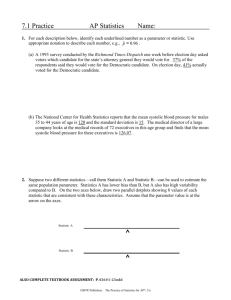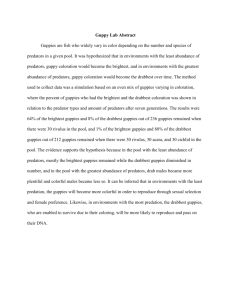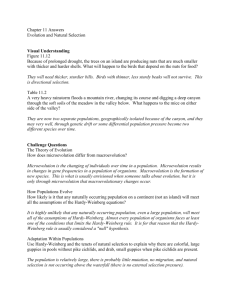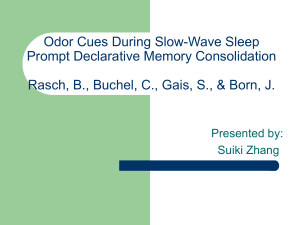Appendix_S1
advertisement
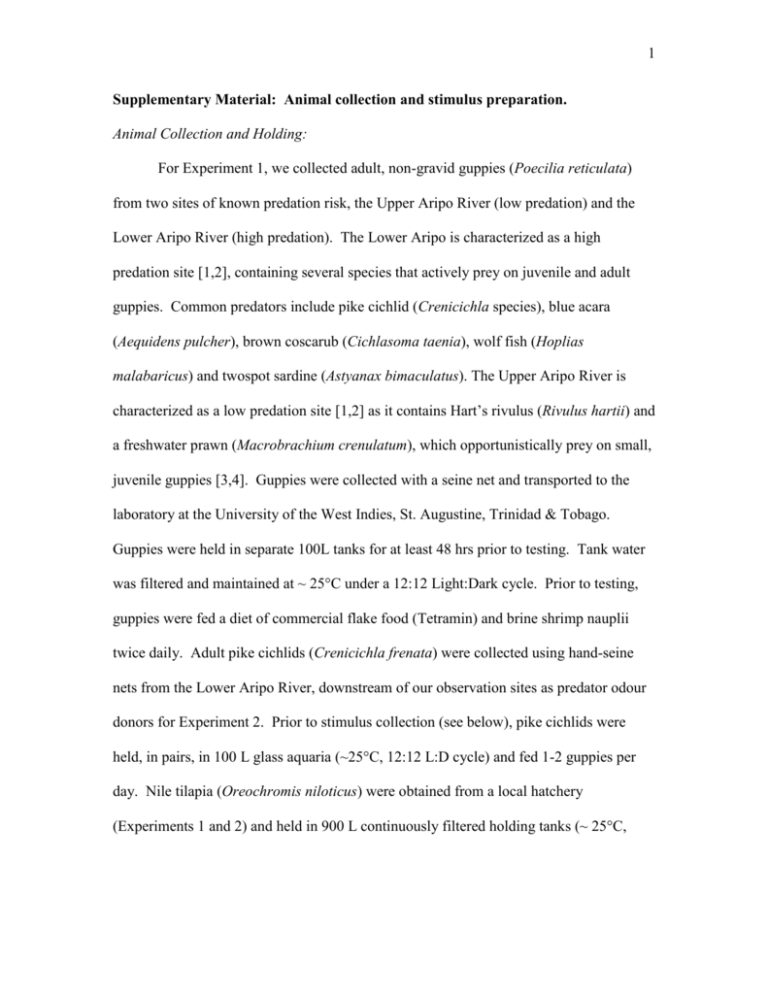
1 Supplementary Material: Animal collection and stimulus preparation. Animal Collection and Holding: For Experiment 1, we collected adult, non-gravid guppies (Poecilia reticulata) from two sites of known predation risk, the Upper Aripo River (low predation) and the Lower Aripo River (high predation). The Lower Aripo is characterized as a high predation site [1,2], containing several species that actively prey on juvenile and adult guppies. Common predators include pike cichlid (Crenicichla species), blue acara (Aequidens pulcher), brown coscarub (Cichlasoma taenia), wolf fish (Hoplias malabaricus) and twospot sardine (Astyanax bimaculatus). The Upper Aripo River is characterized as a low predation site [1,2] as it contains Hart’s rivulus (Rivulus hartii) and a freshwater prawn (Macrobrachium crenulatum), which opportunistically prey on small, juvenile guppies [3,4]. Guppies were collected with a seine net and transported to the laboratory at the University of the West Indies, St. Augustine, Trinidad & Tobago. Guppies were held in separate 100L tanks for at least 48 hrs prior to testing. Tank water was filtered and maintained at ~ 25°C under a 12:12 Light:Dark cycle. Prior to testing, guppies were fed a diet of commercial flake food (Tetramin) and brine shrimp nauplii twice daily. Adult pike cichlids (Crenicichla frenata) were collected using hand-seine nets from the Lower Aripo River, downstream of our observation sites as predator odour donors for Experiment 2. Prior to stimulus collection (see below), pike cichlids were held, in pairs, in 100 L glass aquaria (~25°C, 12:12 L:D cycle) and fed 1-2 guppies per day. Nile tilapia (Oreochromis niloticus) were obtained from a local hatchery (Experiments 1 and 2) and held in 900 L continuously filtered holding tanks (~ 25°C, 2 12:12 L:D cycle). Prior to stimulus collection, tilapia were fed ad libitum with commercial pellets. For Experiment 2, we conducted in situ behavioural observations of guppies in three streams, the Upper and Lower Aripo Rivers and the Tacarigua River. The Tacarigua is characterized as an intermediate predation risk stream. Though it contains a similar predator guild as the Lower Aripo River, the density of predators is lower [1,2]. The juvenile convict cichlids used for Experiment 3 were laboratory-reared descendants of laboratory stock crossbred with wild-caught cichlids from Costa Rica. Prior to testing, cichlids were held 60 L glass aquaria containing filtered dechlorinated tap water (26°C, pH ~7.2, 12:12 L:D cycle) and a gravel substrate. Cichlids were fed twice daily with commercial flake food and brine shrimp nauplii. Rainbow trout (Onchoryncus mykiss) used as predator odour donors (see below) originated from a commercial hatchery (Pisciculture des arepent verts, Ste. Edwidge-de-Clifton, Quebec). Prior to use, trout were housed in recirculating 390 L tanks (~18°C, pH ~ 7.0, 12:12 L:D cycle) and fed, ad libitum, daily with commercial trout chow. Woodfrog egg masses were collected in the middle of the breeding season at our field site, from a local pond in Central Alberta . They were placed in a plastic pool filled with conditioned well, which was left floating on the pond, so the developing embryos and tadpoles would experience identical temperature and weather conditions as the wild ones. The conditioned well water was obtained by filling a 1900-L tub with well water and seeding it with plankton and aquatic plants from the pond. This water is hereafter referred to simply as well water. The embryos and tadpoles were left to develop until Gosner stage 25 [5]. 3 Stimulus Collection: For Experiments 1 and 2, we generated two chemosensory stimuli. Initially, we collected injured conspecific cues, also known as alarm cues, from non-gravid female guppies from both the Upper and Lower Aripo River populations. Fish alarm cues are located in the epidermis, and can only be released in the water column via mechanical damage to the skin, which usually occurs during a predator capture. These cues are known to elicit a strong, innate antipredator response in nearby conspecifics. Cue donors were euthanized via cervical dislocation. Due to the small body size, we used whole body extracts rather than skin extracts [6,7]. We immediately removed the head and tail and placed the remaining tissue into 200 mL of dechlorinated tap water. Tissue samples were homogenized and filtered through polyester filter floss and diluted to the desired final volume with the addition of aged tap water. To control for potential confound associated with population bias in the response to conspecific alarm cues [8], we blended equal quantities of alarm cue from Upper and Lower Aripo guppies and used the combined solution as our stimulus. We collected tissue from 30 Upper Aripo (mean ± SD standard length = 24.43 ± 2.55 mm) and 41 Lower Aripo (21.09 ± 2.83 mm) guppies. We collected a total of 54.72 and 55.57 cm2 of tissue surface area (Upper and Lower Aripo guppies, respectively) and adjusted the final volume to 1100 mL. The final concentration (~0.1 cm2/mL) has previously been shown to reliably elicit increased antipredator responses in Trinidadian guppies [6,7]. The alarm cue was frozen in 20 mL aliquots at -20°C until needed. Sufficient alarm cue was generated for Experiments 1 and 2. 4 Secondly, we collected Nile tilapia odour as a novel predator cue. Nile tilapia do not occur in our test streams and thus represent a ‘novel odour’ to guppies. We placed 10 tilapia (approximately 10 – 12 cm standard length) into a 60-L glass aquarium, filled with 45 L of dechlorinated tap water (~25° C). The tank was unfiltered and tilapia were not fed while in the donor tank. Tilapia were held for 48 hrs and then returned to the holding tanks. Water from the tilapia donor tank was filtered and frozen at -20° in 20 mL aliquots until needed. Sufficient tilapia odour was generated for Experiments 1 and 2 (see below). For Experiment 2, we generated two additional cues: pike cichlid odour and lemon odour. Pike cichlid odour was collected from two donors (14.5 and 12.8 cm SL). Pike cichlids were food deprived for three days prior to odour collection and then were placed, individually, into 20-L glass aquaria (filled with 10 L of dechlorinated tap water) and left for 48 hours. During this time, the cichlids were not fed and the tanks were left unfiltered. Water from pike cichlid donor tanks was filtered and frozen in 20 mL aliquots at -20°C. We also generated a lemon oil cue as a novel, but non-fish and ecologically irrelevant stimulus. We diluted 120 drops of McCormicks Lemon Oil in 300 mL of dechlorinated tap water and froze the resulting solution in 20 mL aliquots at -20°C. Previous studies demonstrate that this concentration of lemon oil is detectable by prey fish [9]. For the cichlid trials (Experiment 3) we generated convict cichlid skin extract from 40 donor cichlids (mean ± SD SL= 35.30 ± 3.80 mm). Donors were killed via cervical dislocation and skin fillets were removed from either side and immediately placed into 300 mL of chilled distilled water. Skin fillets were then homogenized, filtered through polyester filter floss and diluted to the final volume with distilled water. We 5 collected a total of 168.95 cm2 of skin, diluted in 1690 mL of distilled water, to obtain our cue solution (final concentration ~ 0.1 cm2 ml-1). Similar alarm cue concentrations have been shown to elicit an antipredator response in juvenile convict cichlids [10,11]. The alarm cue was frozen in 20 mL aliquots at -20°C until required. We collected the odour of a novel predator (juvenile rainbow trout). Trout odour donors (n = 6; mean ± SD = 9.58 ± 0.44 cm FL) were placed into a 60-L glass aquarium (~ 18°C) filled with 30 L of dechlorinated tap water for 48 hours. The tank water was aerated but not filtered. Trout were not fed during the stimulus collection period. We removed approximately 2 L of water from the tank and filtered it through filter floss to remove any particulate matter. Trout odour was frozen at -20°C in 20 mL aliquots until needed. For the tadpole trials (Experiment 3) injured tadpole cues were obtained by sacrificing tadpoles, and getting a cue solution by using a mortar and pestle and filtering and diluting the solution so that each pail would receive the equivalent of 1.5 crushed tadpoles. We treated 9 pails with injured tadpole cues and 9 pails with water. Following the treatment, 2-3 tadpoles from each bucket were tested for their response to water and others to their response to salamander odour. Tiger salamander odour was obtained by individually soaking 6 salamanders in 2 L of well water for 24 h and combining the odour of 2 randomly chosen salamanders (ranging between 12.6 – 14.8 cm total length). References: 1 Croft, D.P., Morrell, L.J., Wade, A.S., Piyapong, C., Ioannou, C.C., Dyer, J.R.G. et al. 2006. Predation risk as a driving force for sexual segregation: a cross-population comparison. Am. Nat. 167, 867-878. 2 Botham, M.S., Hayward, R.K., Morrell, L.J., Croft, D.P., Ward, J.R., Ramnarine, I. & Krause, J. 200). Risk-sensitive antipredator behavior in the Trinidadian guppy, Poecilia reticulata. Ecology 89, 3174-3185. 6 3 Endler, J.A., & Houde, A.E. 1995. Geographic variation in female preferences for male traits in Poecilia reticulata. Evolution 49, 456-468. 4 Elvidge, C.K., Ramnarine, I.W., Godin, J.-G.J. & Brown, G.E. 2010. Size-mediated response to public cues of predation risk in a tropical stream fish. J. Fish Biol. 77, 1632-1644. (DOI: 10.1111/j.1095-8649.2010.02798.x) 5 Gosner, K.L. (1960). A simplified table for staging anuran embryos and lavae with notes on identification. Herpetologica 16: 183-190. 6 Brown, G.E. & Godin, J.-G.J. 1999. Chemical alarm signals in wild Trinidadian guppies (Poecilia reticulata). Can. J. Zool. 77, 562-570. 7 Brown, G.E., Macnaughton, C.J., Elvidge, C.K., Ramnarine, I. & Godin, J.-G.J. 2009. Provenance and threat-sensitive predator avoidance patterns in wild-caught Trinidadian guppies. Behav. Ecol. Sociobiol. 63, 699-706. (DOI: 10.1007/s00265-0080703-4) 8 Brown, G.E., Elvidge, C.K., Macnaughton, C.J., Ramnarine, I. & Godin. J.-G.J. 2010. Cross-population responses to conspecific chemical alarm cues in wild Trinidadian guppies, Poecilia reticulata: evidence for local conservation of cue production. Can. J. Zool. 88, 139-147. (DOI: 10.1139/Z09-127) 9 Leduc, A.O.H.C., Roh, E., Breau, C. & Brown, G.E. 2007. Learned recognition of a novel odour by wild juvenile Atlantic salmon, Salmo salar, under fully natural conditions. Anim. Behav. 73, 471-477. (DOI: 10.1016/j.anbehav.2006.09.005) 10 Brown, G.E., Bongiorno, T., DiCapua, D.M., Ivan, L.I. & Roh, E. 2006. Effects of group size on the threat-sensitive response to varying concentrations of chemical alarm cues by juvenile convict cichlids. Can. J. Zool. 84, 1-8. (DOI: 10.1139/Z05-166) 11 Ferrari, M.C.O., Rive, A.C., Macnaughton, C.J., Brown, G.E. & Chivers, D.P. 2008. Fixed vs. random temporal predictability of predation risk: an extension of the risk allocation hypothesis. Ethology 114, 238-244. (DOI: 10.1111/j.14390310.2007.01468.x) 7 Supplementary Figures. Figure S1: Mean (± SE) change in time spent moving (A) and foraging attempts (B) for juvenile convict cichlids pre-exposed to low risk cues (distilled water) or high risk cues (alarm cues) and tested for response to distilled water controls (open bars) versus rainbow trout odour (solid bars). N = 20 per treatment combination. 8 Figure S2: Mean (± SE) percent change in the number of line crosses by tadpoles preexposed to low risk cues (well water) or high risk cues (injured conspecific cues) and tested for their response to well water controls (open bars) versus tiger salamander odour.
